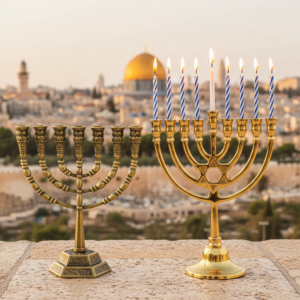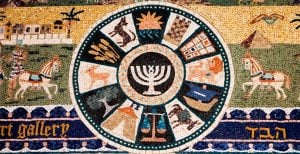Rosh HaShanah, like most Jewish holidays, has several unique food customs associated with it. One of the most popular and well-known has to do with dipping apples into honey, stemming from the age-old Jewish tradition of eating sweet foods to express our hope for a sweet new year. But why specifically apples and honey? Here are 10 connections regarding apples and honey in Jewish tradition:
1) According to Jewish tradition, apples are associated with the Garden of Eden. When Jacob came to receive his father Isaac’s blessings, he was accompanied by the scent of an apple orchard, the “scent of Gan Eden.” ( Rashi on Gen. 27:24 ). This incident took place on Rosh Hashanah.
2) In ancient times, Jewish Sages advised bringing apples to the sick to heal them, perhaps the source of the popular folk saying, “An apple a day keeps the doctor away.”
3) According to King Solomon’s Song of Songs, the apple represents the love between G-d and the Jewish people: “As the apple is rare and unique among the trees of the forest, so is my beloved — Israel — amongst the maidens (nations) of the world.” Similarly, “Beneath the apple tree I aroused your love.”
4) In the Kabbalah, it is explained that the apple symbolizes the G-dly soul. Tapuach (apple in Hebrew) comes from the word Nofach – to blow. G-d blew into man a soul, His own “breath” as it were.
5) When you cut an apple in half horizontally there are ten little holes and a five pointed star. Ten is the numerical value of the Hebrew letter Yud, and five is the numerical value of the Hebrew letter Hey. Those two letters are also an acronym for the words Yad (hand). This reminds us that if we look closely and pay attention we will discover G-d’s hand in our life and the world around us.
6) The custom of honey on the Jewish table during the High Holiday period is an ancient Jewish custom recorded as far back as the works of the Babylonian Geonim in the 7th century.
7) Honey never goes bad. In fact, the ancients used it as a preservative. Jars of honey were found in the pyramids in Egypt unspoiled after thousands of years. It is, hence, a symbol of tradition, a force that is, timeless and stable.
8) The Bible describes the Land of Israel as “flowing with milk and honey,” and thus it is a reminder of the ancient homeland of Israel.
9) The honey referred to in the land flowing “with milk and honey” is not the common bee honey that we use today, but rather describes the honey of Biblical times that was produced from dates.
10) Bees are a non-kosher species of insect life, so why is honey kosher? According to Jewish law, the sac in the bee that contains the honey is considered to be only a storage place of the honey, and neither it nor the honey produced are an integral part of the bee’s body. Yum yum….May it be a happy and sweet New Year!











